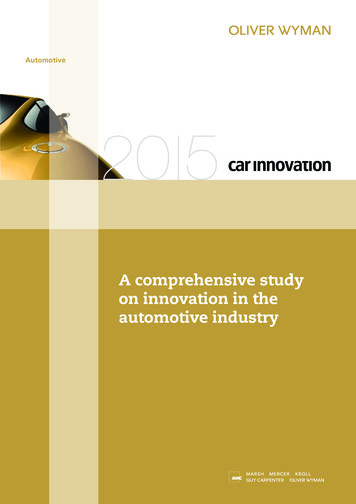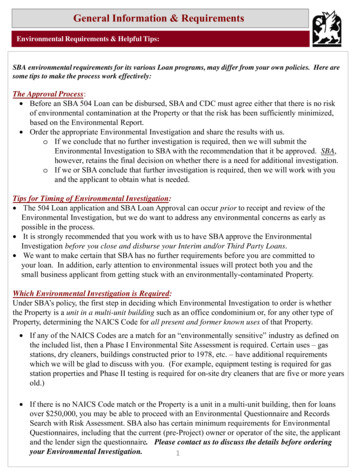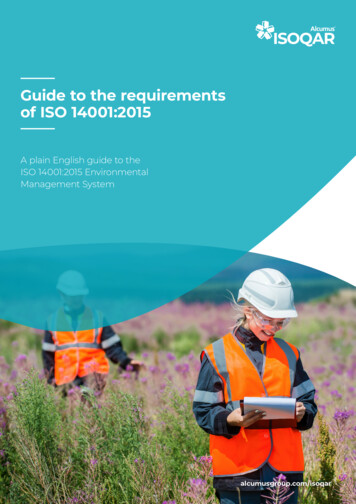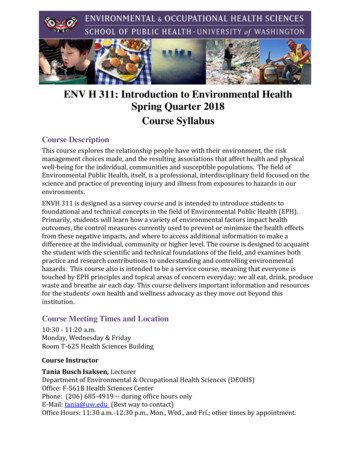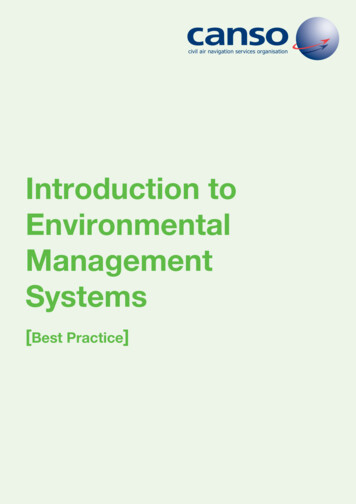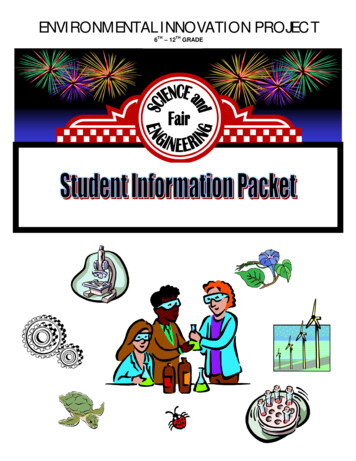
Transcription
ENVIRONMENTAL INNOVATION PROJECTTH6TH– 12GRADE
SECONDARYSCIENCE &STUDENT INFORMATION PACKETRevised 2015Table of ContentsENVIRONMENTAL INNOVATION- - - - - - - - - - PUTTING IT ALL TOGETHER - - - - - - - - - Science Fair Student Information Packet Introduction. 1Helpful Hints for Students . 2Developing a Science Fair ENVIRONMENTAL INNOVATION Project. 3Written Report Content . 4-5Written Report Format . 6Written Report Format for Citing Scientific Research Sources . 7Written Report Format for Sources / Bibliography . 8-9Examples of Data Tables and Graphs . 10-11Display Information . 12Display Size and Set-up for School Site and LBUSD Science Fairs. 13Display Labels . 14-15Display Items . 16Environmental Innovation Rubric Scoring Guide, 6th – 12th Grade . 17Environmental Innovation Targets for Excellence, 6th – 12th Grade . 18- - - - - - - - - - STUDENT APPENDICES - - - - - - - - - Science Topics for Grades 6 -12 . 1Science Project Topic Ideas . 2Student Timeline (Example). 3Materials Sources . 4Community Resources . 5Internet References . 6Library References . 7-8Los Angeles County and CA State Science Fair Reference . 9
SCIENCE & ENGINEERING FAIRSTUDENT INFORMATION PACKETINTRODUCTIONYou are surrounded by science. Everything uses some formof science to make it work. Even the chair you sit on wasmade by a person using tools to build it based on knowledgeof science and technology. How did they know what shapeto make the saw and how sharp the teeth needed to be to cut wood? How did they know to makeone saw for wood and a different one for metal? Why does the wood-cutting saw have larger teeththan the metal-cutting saw?Science is asking questions and finding answers. A science project, simply put, is the process ofasking a question about something you are interested in, for which you don’t already know theanswer, and then hypothesizing (best-guessing) what the answer might be, researching forinformation on that topic, experimenting, inventing, surveying, etc., analyzing your results, andcoming to a conclusion!The purpose of a science fair is to provide a focus for you, the student, to apply skills andconcepts you have learned in science as well as in math, reading, writing, and technology. It givesyou a place to use these skills creatively in your own way.What your accomplishment will mean for you: Developing self-reliance Gaining self-confidence Acquiring organizational skills Knowing what the scientific method is and how it can help you. Having your work viewed and recognized by your school and communityEverything you need to know about doing a great science project is inside this packet. You’ll bediscussing the contents in class. Approximately every two weeks between now and your schoolscience fair, your teacher will give you a Student Timeline for Science Fair Project sheet tocheck your science project’s progress. The timeline sheet is designed to keep you on target, andkeep your teacher and parents informed so that they can help you if neededYou must keep this packet, timeline sheets, letters home to parents, and all otherinformation in a separate folder. Your science fair folder should be kept at home unlessyour teacher asks you to bring it to school.You will find the science fair to be an exciting and rewarding experience. Let’s make this year’sfair the best ever!1
HELPFUL HINTS FOR STUDENTS Start EARLY; don’t wait until the last two weeks before it is due. Plan it out. It will be much more fun if you spread the time out over several days per week orseveral weekends, and you won’t have to race to get it done!It might look like this:Week 1 – Decide on an environmental issue in your neighborhood and or geographicregion.Week 2 – Research current and past attempts to solve the issue, by visiting libraries,universities, making contact with other sources, and checking out web sites.Week 3 – Define and explain your type of innovation. Show how it solves the problem ina new way. Make an action plan and analyze the costs and feasibility of yourinnovation.Week 4 – Implement your plan.Week 5 – Write your report.Week 6 – Make your display. The goal is that you learn to use “the scientific method” or “the engineering design process”through direct experience. Check with your parent or teacher if you want to use a web site for research. Not all web sitesgive correct information. Remember:o Anyone can create a web site; this does not mean its information is correct!o Make sure the web site is run by a large, recognized group such as a college ororganization.o DOT “org”, “gov” or “edu” are generally trustworthy for accuracy of content. What is an acceptable science fair project?o Something that answers a question to which you do not know the answero Something you can figure out yourselfo Something you can change somehow, add another variable, and then predict theoutcome. That’s an experiment! What is NOT an acceptable science fair project?o Reproducing results found on the web is not an experiment; it’s a reproduction.o A demonstration is not an experiment (i.e., volcano).2
ENVIRONMENTAL INNOVATIONDEVELOPING A SCIENCE FAIRENVIRONMENTAL INNOVATIONPROJECT USING THE DESIGN PROCESSFor 6th through 12th GradeCaring for our Earth and its many natural resources is a responsibility we all share. Wehave all seen, heard, and read about issues that threaten the environmental health ofour neighborhood, city, and greater geographic area. All environmental innovationsbegin at a grassroots level with people who take action when they see an opportunityto improve environmental conditions. This project challenges students to identifyenvironmental problems and take steps to solve the problem with innovations, newproducts, community events, and/or awareness campaigns.I.ENVIRONMENTAL PROBLEMState the problem as one sentence in the form of a question. Choose an issue in which youare interested in learning more about.II.PRELIMINARY RESEARCHConduct your research at city and college libraries, interview at least one expert in the field,make contact with other resources and people for information, and compare existingmethodologies and solutions attempted.III.INNOVATIVE IDEADefine and explain your type of innovation. The innovation can be a new product, a new orrevised process, a promotional project to shine light on an issue and offer a solution, or acommunity event to share your new solution.IV.ACTION PLANA.Materials/Resources: Plan, collect, and list the materials or resources you will need foryour innovation, solution, project, and/or community event. Be specific. It is best toborrow, make, or use inexpensive materials.B.Procedure/Timeline: Plan and keep track of the steps of your innovation or projectcarefully and thoroughly. Diagrams are a must, including a timeline (or Flow Map withdates).C.Action: Build or carry out your innovation, solution, or project according to your plan.Record what happens as you go through all action steps, explaining and defining asneeded.V.COST AND BENEFIT ANALYSISAnalyze the monetary and nonmonetary costs associated with the implementation of your plan.VI.REFLECTIONThe reflection describes the challenges and rewards of the project. This is also the place toargue for how practical the innovation is.3
ENVIRONMENTAL INNOVATIONWRITTEN REPORT CONTENT6th - 12th GradeScientists always report their research and experiments so that others may benefit from this newknowledge. Some research is reported through published papers while other work is presented atconventions, on TV, or through the Internet. Your research will be presented through your writtenreport, a project display, and an oral presentation. ABSTRACTThe abstract is a concise summary of your whole project. Others can read the abstract if theydo not have time to read your full report. The abstract must not be more than one page long.It includes your environmental problem and a very brief summary of the innovative idea,research, action plan, cost/benefit analysis and reflection. You will write the abstract after yourreport is complete. TITLE PAGEThe title page belongs after the abstract. The project title must be centered on the page. Seethe Written Report Format sheet for information that needs to be in lower right corner. PURPOSEIn one short paragraph, tell why you did your project on the environmental issue you selected. ACKNOWLEDGEMENTSOn one page, say “thank you” to all the people who helped you with your project. Include anyfamily members, teachers, or experts who assisted you with information, materials, orequipment, or participated in some way in your environmental innovation project. TABLE OF CONTENTSDivide your Table of Contents into sections as indicated on the Written Report Format sheet.Put the actual page numbers at the bottom of each page after you have finished the final copyof your report. ENVIRONMENTAL PROBLEMState the problem as one sentence in the form of a question. Be specific.Your page numbering begins here. PRELIMINARY RESEARCHThis section is a summary in essay form of the information you collected about the history andgeneral background needed by the reader to understand your project. It should include anyprevious research on your topic. Compare existing methodologies and solutions attempted.Take a stand and argue for innovation. Use notes from books, journals, the Internet, magazines,and interviews. If you are required to cite sources within this section, see Written ReportFormat for Citing Scientific Research Sources.4
WRITTEN REPORT CONTENT continued: INNOVATIVE IDEADefine and explain your type of innovation. The innovation can be a new product, a new orrevised process, a promotional project to shine light on an issue and offer a solution, acommunity event to share your new solution. Use visuals and notes to show how yourinnovative idea attempts to solve the problem with a new or original approach. The innovationidentifies a means to minimize impact and counter an environmental threat or problem. ACTION PLANSteps you took to solve the problem with your innovative idea. MATERIALS/RESOURCESBe very specific when listing the materials you used for your innovation, solution, project,and community event. PROCEDURE / TIMELINEClearly explain each step of the action plan and the necessary supports for success such asresources, materials, partnerships, etc. Include dates, times, names, measurements,locations, and problems you had. ACTIONRecord and explain in detail how your solution or innovation worked. Charts, maps,diagrams, and photos are helpful.COST/BENEFIT ANALYSISAnalyze the monetary and nonmonetary costs and benefits and the impacted partiesassociated with the implementation of the action plan. Summarize your analysis in the formof readable and understandable data tables, graphs, and drawings. See Examples of DataTables and Graphs. Write a narrative explanation of your analysis. At the end of yournarrative explanation, analyze why you got the results you did. Include all possible variablesand errors that may have affected the results of your action plan. State whether yourinnovation/solution is feasible or not. REFLECTIONClearly describes the challenges and rewards of the project and the opportunity for numerousapplications. Discuss your personal strengths and possible applications of the innovative idea inother settings. Use evidence from your analysis to argue for the practicality of the innovation.Discuss how you might use what you learned in the future. SOURCES / BIBLIOGRAPHYList all books, articles, pamphlets, and other communications or sources that you used forwriting your preliminary research section. You must have at least five sources, only one ofwhich may be an encyclopedia. College libraries, as well as city libraries, should be used.Interviews with experts in your field of study are encouraged. See Written Report Format forSources / Bibliography.Rewrite your paper several times to correct errors.Have someone you trust proofread your report before you make the final copy.BOXED topics are part of the rubric criteria for judging. The other parts are used only for grading the written report by theteacher.5
ENVIRONMENTAL INNOVATIONWRITTEN REPORT FORMATEach line with a box ( ) in front of it begins a new page in the report. Abstract Title pageTitle in middle of pageIn lower right-hand comer:Last Name, First NameGradePeriodTeacher NameSchool NameDate (include year) Purpose Acknowledgements Table of Contents(with page numbers) Environmental Problem(page numbering starts here) Preliminary ResearchOTHER POINTS TO REMEMBER: Innovative Idea Type or write on one side of paper. Do not put pages in plastic. Make two copies of your originalreport: Original to teacher, onecopy you keep, second copy to useon display board (if you wish). Put report in a store-bought folderwith three brads or rings. Put name, subject, period, date,and teacher’s name on front of thefolder in upper right-hand corner. Action Plan Materials/Resources Procedure/Timeline Action Cost/Benefit Analysis Reflection Sources / Bibliography1. The ORIGINAL report goes inside the report pocket on the display board.2. A COPY should be kept at home or on the computer.6
WRITTEN REPORT FORMATFORCITING SCIENTIFIC RESEARCH SOURCES(When used within the report)Citations are similar to footnotes in English or history papers but are much easier to include. Citationsare included only in the Preliminary Research. Scientific citations are placed within the paper itself,not at the bottom of the page. Citations are placed at the end of a sentence or paragraph thatcontains the information you gathered from another source.Rule 1:Cite all sources that refer to information on your species, experiment, orstudy site.Rule 2: Cite all sources that back up your conclusions.Rule 3: Cite anything that brings in a fact not directly taken from your ownpersonal observations or experiment.Rule 4: When in doubt, cite!EXAMPLES OF PROPER CITING(author, date)White sharks are known to be maneaters (Halstead, 1954). They are the only shark thatregularly preys on marine mammals for food. Some scientists believe that great whites attack humansby mistake: the silhouette of a surfer paddling on a surfboard may be mistaken for a seal sunning onthe surface (Ellis, ed., 1987).(editor, date)VARIATIONS IN SCIENTIFIC CITATIONSOneAuthorTwoAuthorsThree orMore AuthorsNo AuthorsOnly an EditorCiting an Expert YouHave Spoken to orCorresponded with(last name only, date)Example (Bronowski, 1973)(both last names only, date)Example (Walker and Maben, 1980)(all last names only, date)Example: (Cochran, Wiles, and Kephart, 1975)(abbreviated title, date)Example: (Insects of Guam, 1942)(last name only, abbreviation for editor, date)Example: (Ellis, ed., 1987)(last name, “personal communications”)Example: (Collins, pers. commun.)7
WRITTEN REPORT FORMATFORSOURCES / BIBLIOGRAPHYEntries in a Sources / Bibliography section of a report are alphabetized by the last name of the authorand the date is placed directly afterwards. An entry for which the author is unknown, such as anewspaper article or an unsigned review, is alphabetized by the first word of the title, excluding thearticles A, An, and The. Always double-space and indent the second and succeeding lines of eachreference. Do not number your references and if you have two or more references by the sameauthor, alphabetize them starting with the most recently written paper.Books(last name) (initial) (date)One Author(title)(city)(publisher)Bronowski, J. 1973. The Ascent of Man. Boston: Little & Brown, Inc. 376 pp.(total # of pages only)(editor)By EditorEllis, R. (ed.) 1987. Sharks. New York: Wiley, 256 pp.2 Authors,Local AgencyWalker, R. G., and A. Maben. 1980. The Feeding Ecology of Bats.Guam Div. Aquatic & Wildlife Resources. Mangilao, Guam. 44 pp.(agency)(city)(country) (total # of pages)Magazines and Scientific Journal Articles(last name, first initial,3 Authors,Journal Articlethen first initial, last names)(date)(title)Cochran, J. A., Wiles, G. and D. Kephart 1975. “Money, Banking, andthe Economy”. Fortune 34 (4): 47-55.(vol.) (no.) (exact pages)No Author,Scientific Bulletin“Insects of Guam”. 1942. Bernice P. Bishop Museum, Honolulu Bull. 17.(title)(date)(publisher)(bulletin # only)Newspapers(author)Basic Entry(exact day)(title)Kristof, Nicholas D. 3 Jan. 1985: “Oil Futures Plunge on OPEC Doubt.”New York Times, Dl3.(publisher)(section #)8
Encyclopedia, Dictionary, Atlas(author)Article WithinEncyclopedia(date)(title)(specific pages within)Halstead, B. 1954. “Poisonous & Dangerous Marine Animals”. Pp. 105-115 inEncyclopedia Britannica Vol. 93 (C. Brown, ed.), New York: Academic er)Dictionary Entry“Advertisement.” Webster’s Third International Dictionary. (Because the number ofAtlas Entry“Hidden Face of the Moon.” Times Atlas of the World. 1981 ed.the edition appears in the title, the date is not necessary.)Nonprint Sources(director)Video / Film(date)(title)(actors)Shatner, William, dir. 1989. Star Trek V: The Final Frontier. With WilliamShatner, Leonard Nimoy, and DeForest Kelley. Paramount Studios, Hollywood.(studio)(city)(city)(format)Computer Earth. l990. Version 2.0. Sunburst Software, Green Valley, CA. CD or DVD(title)Web Sites(publisher)(date)(source)“How to Produce Award-winning Science Projects”. 2005. Nat. Assoc. ofBiology Teachers Bulletin Board, NABT.edu.(Internet address)Citing “personal communications” with an Expert(in person, on the phone, in letters or on the Internet)(full name and title) (date interviewed)Collins, Dr. Charles 2009. Prof. of Biology, Calif. State Univ., Long Beach, CA(address of work or home)9
EXAMPLES OF DATA TABLES AND GRAPHSDATA TABLESExperimentation that produced data in the form of numbers (quantitative data) must be placed in data tables.Data tables are needed in reports so that you can display your observations (data) in a clear, organized form.Several data tables may be included on one page, as long as the format is clear and easy to read.Data tables should be created on computers. Each table’s columns need headings above them (titles). Anyunits needed (centimeters, seconds, grams, etc.) should appear in the labels, not within the table itself. Rowsmay also need labels to identify a variable.Titles for data tables should go at the top of each table and include a specific description of the kind of data thetable contains. In formal reports, each title should also include the date and location where the data wascollected. High school reports working with specific animals or plants should include the scientific as well asthe common name. Always remember to underline or put into italics all scientific names.Table 1. Earth’s human population since 1 A.D.YEARPOPULATION (in 6.10Table 2. The number of brine shrimp found in sections of tubing after the shrimp were exposedto differences in light, pH, or temperature, on October 2, 2009 at Poly TpHTEMPERATURE (oC)CONTROL5 (brightest)13 (pH 5.5)68 (coldest)231537 (pH 6.7)64346876 (pH 7.8)322150 (darkest)65 (pH 8.6)44 (warmest)37GRAPHSGraphs are a perfect way to visually present your data. A data table will show your results in numbers, but isoften uninteresting or difficult to interpret. A graph can take the same data, make it eye-catching and easilyshow large differences in your results. Graphs show comparisons between two or more groups or differencesbetween variables.A graph cannot stand alone - it must be preceded by a data table. The data table contains exact details froman experiment that a graph often cannot show. They complement each other: one gives the details, onedisplays the trends.Label both the X and Y axes and include any units necessary (grams, centimeters, etc.). Data fromdependent variables (data that vary as the experiment continues) are placed on the Y axis. Data fromindependent variables (data that do not vary during the experiment, such as the days of the week,experimental group numbers, and time periods) are placed on the X axis.10
Graphs must be properly titled. The formal title for a graph goes at the bottom of the graph and like a datatable, includes a description of the kind of data the table contains. In formal reports, each title should alsoinclude the date and location where the data was collected.An Example of a BAR GRAPH# of brine shrimp(Three variables and the control are graphed)The number of brine shrimp preferringvarious levels of light, pH, and temperature.(See Table 1 for details.)An Example of a LINE GRAPH(Three variables and the control graphed)The number of brine shrimp preferringvarious levels of light, pH, and temperature.(See Table 1 for details.)NOTE: The preceding examples show three variables graphed. It is suggested that you use only one variablein your experiment unless you have teacher permission. Also, the preceding examples are of a bar and linegraph. As you know, there are other types of graphs that you have seen or made in science and other classes.You may select the type of graph(s) you would like to use in your written report.11
ENVIRONMENTAL INNOVATIONDISPLAY INFORMATIONBACKBOARD MATERIALSDRAWINGS, PHOTOS ANDGRAPHSThe backboard must be sturdy and stand byitself on a table. Foam core-board andcardboard are the best materials. If you needto cut through the sides of your core-board tomake “wings”, do not cut all the way through.Drawings and photos are most useful on thedisplay. Drawings should be drawn in pencil firstand then retraced. Drawings should be in colorand outlined in thin black felt tip pen. Graphsand charts must be used in the results section.They may be computer-generated. All graphsand charts must have explanatory titles. Graphaxes must be labeled.COLORSIf you need to paint your backboard, enamelpaint works best. Do not use water-basedpaint. Contact paper may also be used. Use aminimum of three contrasting colors on yourboard.If you have a camera, you should photographyour environmental innovation. A photo of youwith your project is encouraged. All photos mustbe titled.LETTERINGYour title and subtitles may be computergenerated or cut from construction paper. Donot freehand the letters. The title letters shouldbe 3-4 inches high. The subtitle letters shouldbe 1-2 inches high. The subtitles, which aremandatory on the display board, are:Environmental Problem, Innovative Idea,Action Plan, Cost/Benefit Analysis,Reflection, and Report. All items on thedisplay must be glued to the board. Do not usepins, tacks, staples, or tape.DISPLAY DIMENSIONS1. When backboard (display portion) is flat, itshould be 48 inches wide.2. Side panels (“wings”) should be l2 to l8inches.*3. Height should be no more than 48 inches.REPORT POCKETThere must be a “pocket” on the display to holdyour report.When you have decided what you are going to put on the backboard (display),lay the unglued display on the floor and look at it carefully. Have family andfriends look at it and ask their opinions. Then, you should glue everything intoplace. Examples of displays will be shown and discussed in class.12
DISPLAY SIZE & SET-UPFOR SCHOOL SITE AND LBUSD SCIENCE FAIRSMinimum sizes are suggested, not required.DRAWINGSPHOTOSGRAPHSYou may decide where to place these elements on your board.This example is to give you an idea of what a display boardfor a project might look like.13
SECONDARY ENVIRONMENTAL INNOVATIONDISPLAY LABELSENVIRONMENTALPROBLEMINNOVATIVEIDEAACTION PLAN14
COST/BENEFITANALYSISREFLECTIONREPORT15
DISPLAY ITEMSPart of your display should include something that represents the project and should be placed infront of or on the display board. Depending on the type of project you do, the display items may ormay not be the focus of the display.If you cannot decide what to use to represent your project, brainstorm with family, friends, andclassmates. Keep in mind that the items you choose will set the tone for your display and must beapproved.No part of your display may pose a safety hazard. Do not include harmful chemicals, bacterialcultures, sharp objects, or any source of heat or flames. No live or preserved animals are allowed atthe LBUSD district-level science fair, at the Los Angeles County Fair, or at the California State Fair.Some examples of display items are listed below: Equipment or materials you have built or used as part of your project or experiment (i.e.,an incubator, variously shaped kites, a solar oven, a microscope with slides, etc.) Models Artistic representations of your topic (i.e., a large paper maché nose for an odor project,toothpick bridges for a physics project, or a collage of leaves for a plant project) Samples or specimens Simulated items such as photos, video, and audio taken while working on your project orduring your experiment. (Keep in mind that use of extension cords requires specialpermission.)There are endless possibilities. Be creative! Put on your thinking cap!16
Environmental InnovationSCIENCE &EnvironmentalProblemPreliminaryResearch(Double Points)(x2)Innovative Idea(Double Points)(x2)Action Planwith Timeline(Double Points)(x2)Cost/BenefitAnalysisReflectionVisual Qualityof Display(6-12th Grade)Rubric for School Site FairAttemptedProficientAdvanced Proficient1 point3 points5 pointsStates the environmental issue or problem as aStates the environmental problem as a questionStates environmental problem as a question,question, provides evidence that it comes fromthat is vague, or as a statement, or addresses anwhich represents a genuine learning opportunity the student’s personal interests or experiences,issue to which the student already knows thefor the student. Generally addresses a benefit to and represents a genuine learning opportunityanswer. Shows limited or no connection tosociety.for the student. The project has a specificsocietal benefit.beneficial application to some aspect of society.Uses limited sources from only one type ofinformation resource (e.g., text, encyclopedia,Uses three or more reputable sources, citedUses five or more reputable sources, citedbusinesses, magazines, catalogs, internet, orcorrectly. Cites more than one type ofcorrectly. Cites at least four types of informationinterviews), or uses some resources that are not information resource. Mentions otherresources. Compares their idea to existingreputable sources. Fails to connect to othermethodologies and solutions attempted.methodologies and solutions attempted.attempts to address this problem.Explains the innovative idea. Visuals and notes Clearly explains the innovative idea in detail.Attempts to explain the innovative idea. Visualsshow that the idea attempts to solve the problem Visuals and notes show how the idea attempts toand notes may be incomplete or fail to show awith a new or original approach. The studentsolve the problem with a new or originalnew or original approach. It may be unclear howidentifies at least one way their idea couldapproach. The student identifies specific waysthe idea could possibly minimize impact orpossibly minimize impact or counter the threat of their idea will minimize impact or counter thecounter the threat of the environmental problem.the environmental problem.threat of the environmental problem.Timeline of the action plan may be incomplete orneglects to supports for success, such asresources, materials, partnerships, etc. Actionstep labels or explanations are vague or missing.Student does not mention both monetary andnonmonetary costs/benefits. Or, neglects to noteparties that would be impacted byimplementation of the action plan.Student is unclear about challenges and rewardsof the project. Makes vague applications topersonal strengths or neglects possible use ofthe idea in other settings. Neglects or argueswith little evidence about the practicality of theinnovation.Project has limited eye appeal or is not easilyreadable at approximately two feet distance.The project has limited organization, or containsconfusing visuals, or contains major language orspelling errors.
ENVIRONMENTAL INNOVATION DEVELOPING A SCIENCE FAIR ENVIRONMENTAL INNOVATION PROJECT USING THE DESIGN PROCESS For 6th through 12th Grade Caring for our Earth and its many natural resources is a responsibility we all share. We have all seen, heard, and read about issues that threaten the environmental health of




